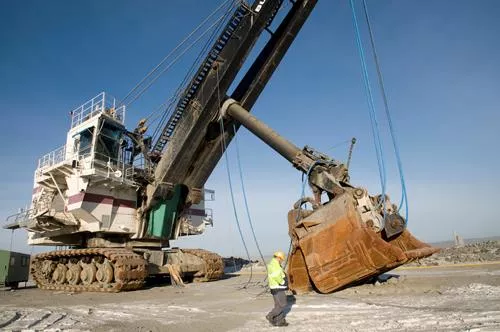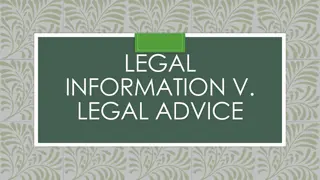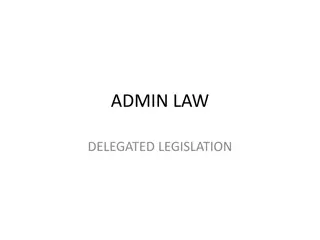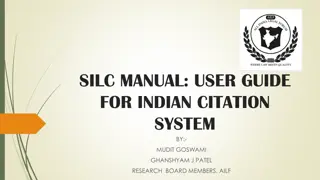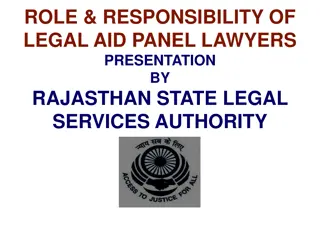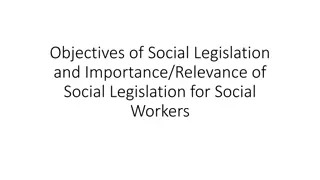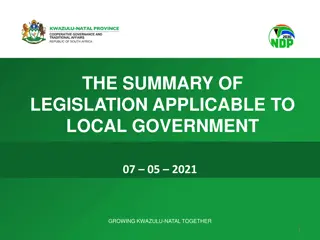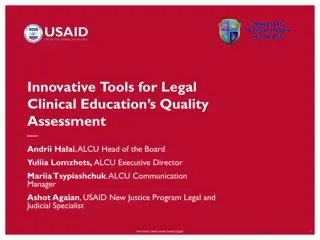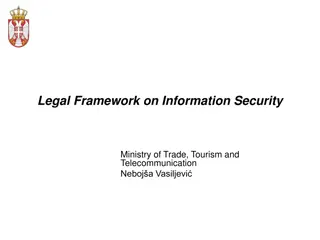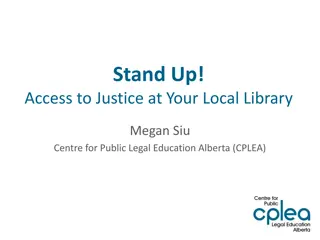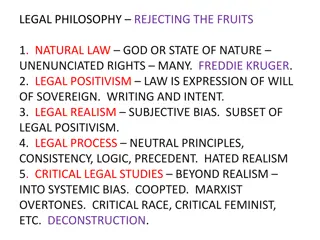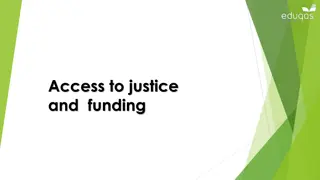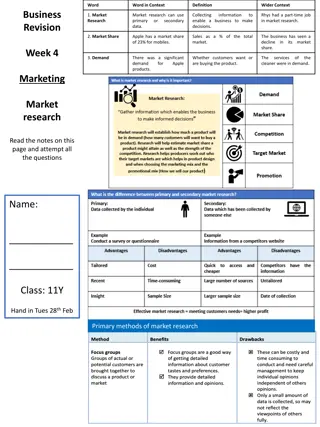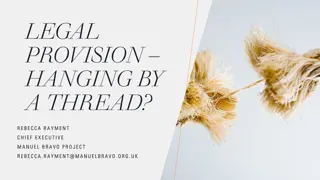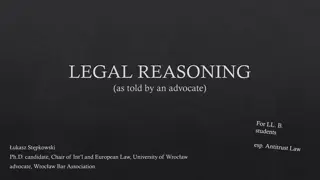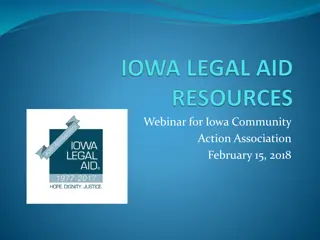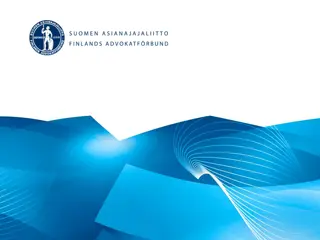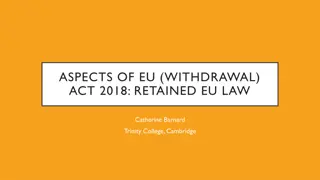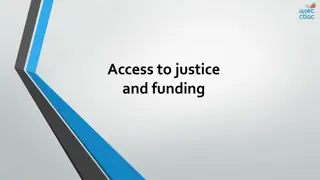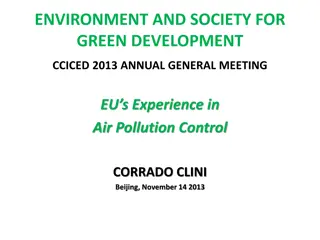Legal Framework and Market Analysis of EU Legislation
The analysis of EU legislation related to the mineral resource sector discusses the alignment with global mineral investment criteria, implementation issues in Member States, and the importance of internal market principles. The study highlights the role of key directives and strategies in promoting a sustainable mineral supply from European sources. Areas of concern include restrictions on freedom of establishment, lack of transposal of certain directives, and disparities in national environmental frameworks. The Services Directive is emphasized as crucial for mineral resource permitting processes, with a focus on simplification, impartiality, and transparency requirements.
Download Presentation

Please find below an Image/Link to download the presentation.
The content on the website is provided AS IS for your information and personal use only. It may not be sold, licensed, or shared on other websites without obtaining consent from the author.If you encounter any issues during the download, it is possible that the publisher has removed the file from their server.
You are allowed to download the files provided on this website for personal or commercial use, subject to the condition that they are used lawfully. All files are the property of their respective owners.
The content on the website is provided AS IS for your information and personal use only. It may not be sold, licensed, or shared on other websites without obtaining consent from the author.
E N D
Presentation Transcript
Euromines Conclusions of MINLEX study 2017
Conclusions The analysis of the EU legislation shows that the TFEU, relevant conventions, and the EU Internal Market, Environmental, Nature Conservation, Water, Emissions, Chemical Safety, Extractive Waste and Occupational Health & Safety Directives provide an adequate legal framework for the NEEI sector and establish principles (security of tenure, free movement of capital, freedom to provide services, freedom of establishment, legal certainty, equal treatment, transparency, non-discrimination, administrative simplification), and guarantees aligned with globally accepted mineral investment criteria. This legal framework combined with the EU s Raw Materials Strategy framework (RMI, EIP-RM), provide a strong basis for achieving a sustainable supply of minerals from European sources and sets the right conditions for the MSs to streamline their NEEI permitting procedures. www.euromines.org 2 European Association of Mining Industries, Metal Ores & Industrial Minerals www.euromines.org
Conclusions (2): Basic internal market principles are respected and followed by the MSs. Nevertheless, our analysis has identified implementation issues in some MSs such as restrictions in the freedom of establishment and the freedom to provide services, lack of transposal of the Transparency Directive, overly restrictive approaches towards the implementation of the Nature Directives (an issue raised mainly by industry stakeholders), the introduction in national legal environmental frameworks of protective measures more (or less) stringent than those laid down in the EIA Directive, among others, all of which act against a level playing field in the EU s internal market. www.euromines.org 3 European Association of Mining Industries, Metal Ores & Industrial Minerals www.euromines.org
Conclusions (3): Service Directive The Services Directive is a principal item of the internal market legislation and particularly important for mineral resource permitting. An important provision of the Services Directive is Point (43) of the Preamble which explains the requirements of simplification of administrative processes which can be directly applied to one-stop shops in the NEEI permitting. Another important provision is Art. 12 which establishes that selection from among several candidates is required providing full guarantees of impartiality and transparency (Art. 12(1)) in case of limited availability of authorisations for a given activity, which is typically the case for scarcely occurring potential mineral deposits. Consequently, authorisations have to be granted through a selection procedure ensuring impartiality and transparency of the process. Our current analysis shows that the previously mentioned criteria (impartiality, transparency) are only fulfilled in the mining legislation of some MSs. www.euromines.org 4 European Association of Mining Industries, Metal Ores & Industrial Minerals www.euromines.org
Conclusions (4): Concessions Directive The overall objective of the Concessions Directive which establishes rules on the procedures for procurement by contracting authorities and contracting entities by means of a concession is to apply clear rules in awarding concession contracts. This Directive, given the utilisation of the concession system by many MSs to entrust operators with exploration or extraction activities, would be relevant for permitting procedures, but, due to its present scope and from a strict legal perspective, is not applicable for the NEEI. www.euromines.org 5 European Association of Mining Industries, Metal Ores & Industrial Minerals www.euromines.org
Conclusions (5) Transparency Transparency of economic activities is a key requirement of the internal market. The EU has made definite steps towards the compliance with the requirement of the Extractive Industry Transparency Initiative (EITI), but to date, only two MSs (DE, UK) are members and only FR has announced its intention to apply for membership, and one MS (RO) has not yet transposed the Directive. www.euromines.org 6 European Association of Mining Industries, Metal Ores & Industrial Minerals www.euromines.org
Conclusions (6): EIA Directive With regards to the implementation of environmental protection legislation, we have identified differences in the transposition of the EIA Directive by MSs, in some cases via the implementation of environmental protection measures more stringent than those required in the EIA Directive, which results in dissimilar administrative burdens or threshold values through which a proposed project becomes subject to an EIA. www.euromines.org 7 European Association of Mining Industries, Metal Ores & Industrial Minerals www.euromines.org
Conclusions (7): Nature Directives Our assessment of the implementation of the Nature Directives shows many good examples of cases where the NEEI sector contributed to nature and biodiversity conservation objectives. At the same time we found examples of implementation difficulties such as overly restrictive approaches in the implementation of the Directives provisions by MSs (reported by industry stakeholders), insufficient assessment of mitigation measures and alternative solutions obstructing permitting processes, among other difficulties which have adversely affected permitting procedures. It has been found that such differences in the way of implementing the EIA and Nature Directives act against a level playing field in the EU s internal market and in the permitting procedures. www.euromines.org 8 European Association of Mining Industries, Metal Ores & Industrial Minerals www.euromines.org
Conclusions (8): Extractive Waste Directive The analysis of the Extractive Waste Directive (questions three to six of the Structured Questionnaire) shows that MSs are implementing the Directive in different ways. MSs differ widely as to whether to apply risk assessment for the qualification of a waste facility, in which way to apply relief for disposal of inert or non-hazardous non-inert waste, and as to applying an inert waste list. This also acts against level playing field conditions www.euromines.org 9 European Association of Mining Industries, Metal Ores & Industrial Minerals www.euromines.org
Conclusions (9): financial parameters The financial parameters examined in this study, such as resource tax (royalty) payment rules and rules for charging permitting fees for exploration and extraction show heterogeneity of the financial regimes between MSs derived from differences in national mining legislation and policies as well as ownership rules. These also act against the level playing field within the EU s internal market. www.euromines.org 10 European Association of Mining Industries, Metal Ores & Industrial Minerals www.euromines.org
Conclusions (10): investments In many MSs investments in the NEEI sector are currently being affected by unpredictable and inefficient permitting procedures which reduce investment security and legal certainty necessary for investors. While the speed of the process is mainly determined by the rules of the permitting regimes and the resources and technical capacity of competent authorities, the predictability of the outcomes depends on the complexity of the mineral development project, i.e. on the location of the proposed development, on the extraction method proposed, its potential socio-environmental impacts, on the degree of social acceptance of the industry, wether good governance practices were followed by the developer (e.g. to look early for suitable alternatives), among other factors. www.euromines.org 11 European Association of Mining Industries, Metal Ores & Industrial Minerals www.euromines.org
Conclusions (11): permitting Concerning the permitting authorities, delays of permitting procedures may be caused by one or a combination of the following factors: a lack of statutory timeframes (deadlines) for authorities to make decisions, lack of specialised staff, insufficient technical capacity to evaluate complex project proposals, lack of sufficient competence and ability to handle conflicts of interest and seek compromises, due to political/electoral reasons, lack of knowledge to apply existing guidance documents (e.g. on EC s guidance on non-energy mineral extraction and Natura 2000). A result of the latter and with regards to the implementation of the Nature Directives, it has been reported by industry associations (in the last fitness Check of the Nature Directives) that competent authorities granting permits tend to apply overly restrictive interpretations (e.g. a priori restrictions) due to either a misinterpretation of the Directives and/or lack of knowledge. When appeals are lodged against permits granted by the mining authority (or any other), second-instance permitting authorities (in case they are different to the first-instance) may also be constrained by the previously mentioned factors, especially by the lack of technical background to evaluate complex and voluminous project descriptions, which creates further delays and unpredictable outcomes. www.euromines.org 12 European Association of Mining Industries, Metal Ores & Industrial Minerals www.euromines.org
Conclusions (12): permitting Delays can also sometimes be caused by a co-authority participating in an appeal against the decision by the competent authority; however, we have found few cases in our database (only 7 % of the cases, 6 in total, were appealed by authorities). The importance of the factors varies across MSs, but in general, lack of staff and insufficient technical capacity to evaluate complex proposals have often been mentioned. www.euromines.org 13 European Association of Mining Industries, Metal Ores & Industrial Minerals www.euromines.org
Conclusions (13): permitting Another reason that render permitting procedures inefficient may be associated with the developers: on one side companies, sometimes due to lack of knowledge or negligence, may incur in procedural mistakes (e.g. incompatibilities, the application does not comply with the necessary formalities). According to our court cases database, permitting administrative issues and other procedural questions comprise nearly one third of the court cases and in more than half of the cases the plaintiffs were operators/developers, followed by NGOs (14 %) and municipalities (10 %). It has also been reported that companies may prepare and present low quality environmental studies (EIA or Appropriate Assessments) which most likely leads to delays and potential refusals of permits. Moreover, the omission or inadequate early and meaningful stakeholder consultation and community outreach procedures with the relevant stakeholders may also lead to long delays. www.euromines.org 14 European Association of Mining Industries, Metal Ores & Industrial Minerals www.euromines.org
Conclusions (14): participation of the civil society The active participation of the civil society (civil groups, individuals, neighbours, NGOs) through judicial measures (27 % of all court cases analysed261), especially in nature conservation and environmental protection cases, may also contribute to delays during permitting procedures. The right of the civil society to participate in the permitting process should be highly respected by all MSs as it is a fundamental right established in the Aarhus Convention and consequently in the EU legislation. Our analysis finds that public participation is a sensitive and complex issue. We also found that the issue of the social acceptance of the industry by the general public is an area that requires more intensive efforts (especially by the industry) to improve communication and ensure best practices are applied. If the public acceptance of the extractive industry in a country falls due to an accident (as the cases of e.g. Talvivaara in Finland, Baia Mare in Romania), it will most likely result in a stronger activity of civil groups, a stronger scrutiny of the industry by the wider public (and permitting authorities), and may even trigger opposition to permitting of NEEI projects for several years or even more. www.euromines.org 15 European Association of Mining Industries, Metal Ores & Industrial Minerals www.euromines.org
Conclusions (15): location of a potential project The location of a potential project is a very important factor for permitting procedures due not only to the socio-cultural setting (which determines the level of social acceptance of the mining industry, e.g. due to the history of the area, how important the mining industry has been in creating jobs and shaping the life of a town, if serious accidents happened in the past, etc.) but also to the competing land uses which determines how difficult or easy it may be for a developer to get the mineral development proposal accepted. Those jurisdictions where spatial planning effectively identifies and/or safeguards areas for exploration or extraction (and for other lands uses) facilitate permitting procedures (goes quicker, costs less, less conflicts). www.euromines.org 16 European Association of Mining Industries, Metal Ores & Industrial Minerals www.euromines.org
Conclusions overall Although many of the implementation difficulties identified in this report have already been mentioned in previous studies, only a few Member States have implemented structural changes in their permitting legal frameworks and regimes to substantially modify them and increase their transparency, predictability and efficiency. As a result, we can conclude that the NEEI sector is favoured in some regions but still remains in general undermined by multiple implementation difficulties which adversely affect NEEI permitting procedures and prevent such sector from having a level playing field in the EU s internal market. www.euromines.org 17 European Association of Mining Industries, Metal Ores & Industrial Minerals www.euromines.org
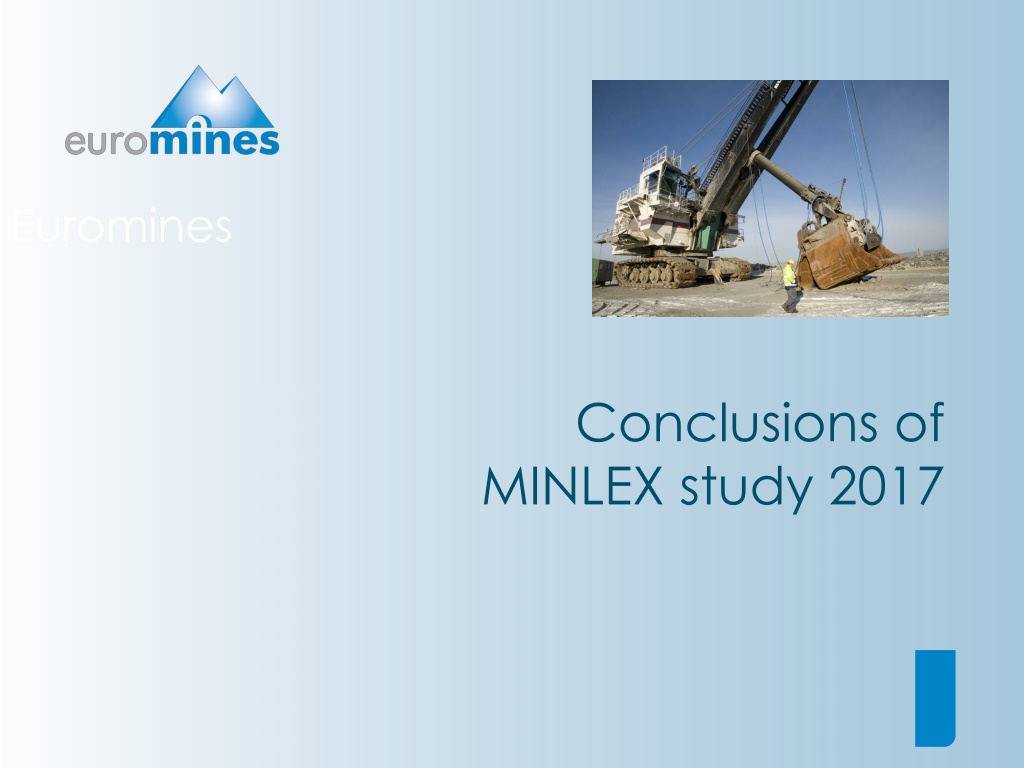
 undefined
undefined

